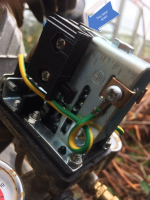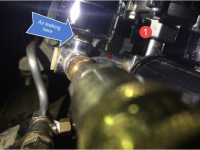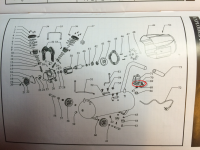Not sure how you went about troubleshooting, so apologies if you've done this. You didn't say that the motor buzzed or hummed, just that it was 'dead' so I'm thinking an electrical problem:
Before I go any further, did you look for a circuit breaker on the motor itself? It will typically look like a little plastic button around 1/4" to 3/8" in diameter. IF you find it, press it in. If it goes 'click' you may have found your problem.
All of the following assumes that you can be safe around electricity. If you aren't/can't, either find a friend who can or hire someone to fix it - we don't want to lose you from the forum due to one mistake with 240 volts!
So let's start troubleshooting...
1. Check for voltage at the point where the wires attach to the compressor - usually either at the on-off switch or the pressure switch. Do you have power there?
If no, track your circuit back to the panel, and don't forget to check the breaker itself - they DO go bad!
If yes, then:
2A. If power comes into the pressure switch, check to see if you have power on the other (output) side of the switch.
If no, your pressure switch is not working. It may be something as simple as the insect mentioned above, but it may also have failed in another manner. If it's bad and you can't fix it, you'll need to replace it.
If yes, then track your circuit on to the next junction point, which will probably be the on-off switch
2B. If power comes into the on-off switch, check to see if you have power on the other (output) side of the switch. I know that this is obvious, but make sure you've turned the switch to the ON position before testing?
If no, your power switch is not working. It may also be something as simple as the insect mentioned above, but it may also have failed in another manner. If it's bad and you can't fix it, you'll need to replace it.
If yes, then track your circuit on to the next junction point, which will probably be the pressure switch.
3. Once you've followed power thru both the on-off and pressure switches, the next likely connection point will be at the motor. Usually there will be a junction box with a removable cover mounted directly on the motor. Remove the cover and examine the interior of the junction box. Since your compressor has been outdoors, it's entirely possible that you've had rodents or other n'er-do-wells make a nest inside of the box. It wouldn't surprise me if you found a carcase or two in there. WITH THE POWER OFF remove said carcase and anything else that doesn't belong in there. Examine the wires for missing insulation or other damage. Repair or replace as necessary.
4. Turn power back on, and with the power switch ON and the pressure switch tested, CAREFULLY verify power into the junction box on the motor. You might have to temporarily expose one or both of the power leads that connect to the motor wiring, so use care. IF you have power to the motor, TURN THE POWER OFF at the breaker and reconnect the wires to the motor.
5. Test it once more:
If it starts up, you're good!
If you hear nothing, your motor is bad and needs repair or replacement.
If you hear humming or buzzing, then:
Note: from here on I assume that your compressor is belt drive. If it's not you can disregard this part.
6. WITH POWER OFF, try to turn the pulley on the compressor pump by hand. It will be difficult, but you should be able to move it.
If you can turn it, you have a motor problem. You are finished troubleshooting.
If you can't turn it, then:
7. Remove the belt that connects the motor to the compressor. Try to turn the compressor pulley again.
If you still can't turn it, the compressor pump is likely seized and will need to be repaired or replaced. You are finished troubleshooting.
If you can turn it, then:
8. Make sure everything is clear of the motor pulley and turn the power back on. Turn the power (on/off) switch on.
If the motor runs, you've verified that the compressor pump is excessively difficult to turn, is likely 'binding' somehow, and will need to be repaired or replaced. You are finished troubleshooting.
If the motor doesn't run, you've verified that the motor will need to be repaired or replaced. You are finished troubleshooting.
Obviously I can't cover every possible problem you might find, but this will help you track down the most likely issues fairly quickly.
Good luck!



